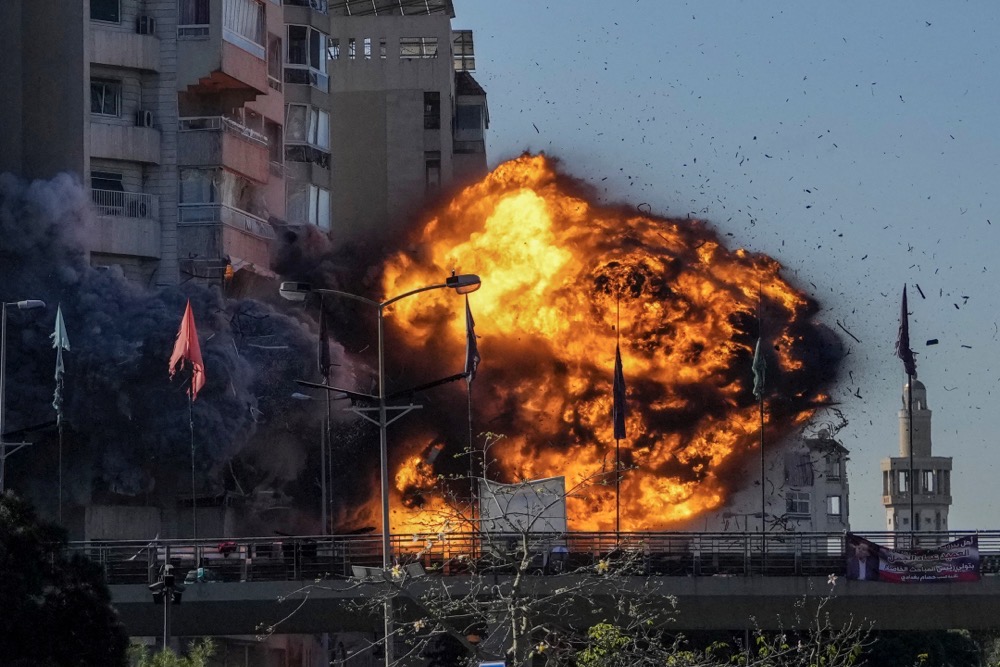JERUSALEM: US Secretary of State Antony Blinken urged Israel’s leaders to work toward a ceasefire in Gaza on Tuesday, the latest call for a truce coming as fighting raged in the territory’s aid-starved north and Israeli strikes hit Lebanon.
Blinken is on his 11th trip to the Middle East since Hamas’s attack on Israel more than a year ago triggered the Gaza war, and his first since Israel’s conflict with Lebanon’s Iran-backed Hezbollah escalated last month.
The top US diplomat told Israel’s leaders that the army’s killing of Hamas leader Yahya Sinwar last week presented an “opportunity” for a truce and the release of the hostages Hamas seized during the October 7, 2023 attack.
“I believe very much that the death of Sinwar does create an important opportunity to bring the hostages home, to bring the war to an end and to ensure Israel’s security,” Blinken said as he met Israeli President Isaac Herzog in Tel Aviv.
During an earlier discussion with Prime Minister Benjamin Netanyahu in Jerusalem, Blinken pressed for more aid to be allowed into the besieged Palestinian territory as concerns rise for tens of thousands of civilians trapped by a major Israeli assault in the hard-to-reach north.
A US official said that Netanyahu had recognized the “seriousness” of Blinken’s warnings to ramp up aid access to Gaza, “but it’s the results that matter.”
Washington has warned it may suspend some of its military assistance if Israel does not quickly improve humanitarian access to the area.
Netanyahu also denied claims that Israel was implementing a controversial plan for an intense siege to starve out northern Gaza, the US official said.
Previous efforts by the United States — Israel’s top ally and main arms supplier — to end the Gaza war and contain the regional fallout have failed, as did a previous bid to secure a temporary ceasefire in Lebanon.
Blinken’s visit comes as Israel weighs its response to Iran’s missile attack on October 1.
Defense Minister Yoav Gallant told Blinken that Israel expects Washington’s support “following our attack on Iran,” his office said.
Blinken again called for a “diplomatic resolution” in Lebanon and compliance with a UN resolution that ended Israel’s last war with Hezbollah in 2006.
After Israel, Blinken will visit Saudi Arabia on Wednesday, a last-minute change from plans to head to Jordan caused by scheduling issues, a US official said.
Fighting meanwhile raged in Lebanon, with the Israeli military issuing new calls for residents to evacuate areas in the southern suburbs on capital Beirut on Tuesday evening, warning of imminent attacks.
After nearly a year of war in Gaza, Israel shifted its focus to Lebanon in late September, vowing to secure its northern border to allow tens of thousands of Israelis displaced by cross-border fire to return to their homes.
Israel ramped up its air strikes on Hezbollah strongholds around the country and sent in ground troops late last month, in a war that has killed at least 1,552 people since September 23, according to an AFP tally of Lebanese health ministry figures.
On Tuesday, an Israeli strike on the eastern Hermel region killed five people, while five more died from a separate strike in the southern city of Nabatiyeh, the ministry said.
An Israeli air strike near a Beirut hospital overnight killed 18 people, four of them children, according to the health ministry.
The strike flattened four buildings near the Rafic Hariri Hospital, Lebanon’s biggest public health facility which is located outside Hezbollah’s traditional strongholds, an AFP correspondent reported.
Resident Ola Eid said she was tossing children chocolate and candy from her balcony when her neighborhood was bombed.
“Before they could even catch them, the first strike hit, then a second. I saw the children ripped apart,” she told AFP.
UN human rights chief Volker Turk said he was “appalled” by the strike.
Another Israeli strike on Tuesday came just minutes after a Hezbollah official cut short a news conference in response to an Israeli evacuation warning, an AFP correspondent said.
Hezbollah said it launched attack drones at an Israeli military base south of the coastal city of Haifa on Tuesday, with the group also saying it struck seven tanks at the border.
In the Gaza Strip, Israel launched a major air and ground assault in northern Gaza earlier this month, vowing to stop Hamas militants from regrouping in the area.
Despite the exodus of tens of thousands of civilians, around 400,000 have been trapped by the fighting, the UN agency for Palestinian refugees warned last week.
Paramedic Nevin Al-Dawasah said she was trapped for 16 days in a shelter for displaced people in the Jabalia refugee camp, the focus of the recent fighting.
When an Israeli army drone equipped with loudspeakers told them to evacuate, they started leaving “but suddenly there was shelling” that killed some people and wounded others, Dawasah told AFP.
The only medical facility still only partially functioning in the targeted area of northern Gaza has “no medicine or medical supplies,” warned Kamal Adwan Hospital director Hossam Abu Safia.
“People are being killed in the streets, and we can’t help them. Bodies are lying on the streets.”
The war was sparked by Hamas’s unprecedented attack on Israel on October 7 last year, which resulted in the deaths of 1,206 people, mostly civilians, according to an AFP tally of Israeli official figures.
Israel’s retaliatory offensive has killed 42,718 people in Gaza, also mostly civilians, according to figures from the Hamas-run territory’s health ministry which the UN considers reliable.
Blinken urges Israel to reach Gaza truce, allow more aid
https://arab.news/rf3am
Blinken urges Israel to reach Gaza truce, allow more aid

- Trip comes little more than week after US threatened to withhold some US aid without progress in delivering assistance to Palestinians
- Blinken said killing of Hamas leader Yahya Sinwar last week presented an ‘opportunity’

































